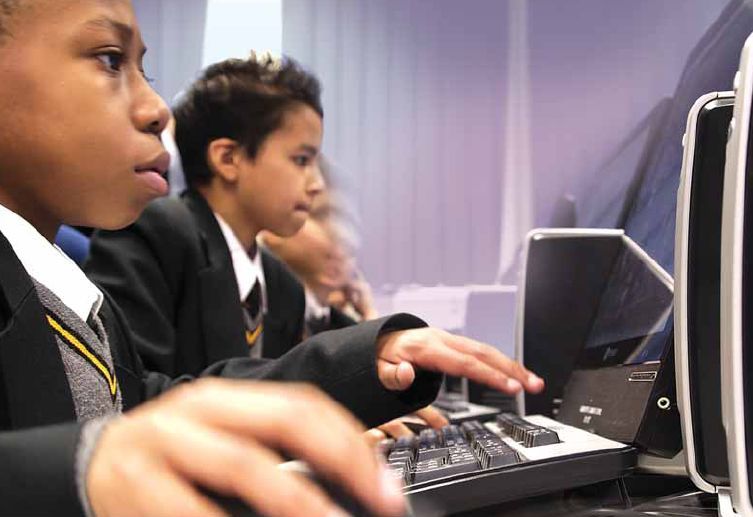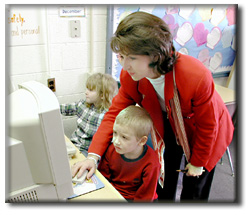Consortium unveils the UK school of the future
Re-Thinking model school shows what education can be environmentally friendly and technologically innovative.


Schools of the future will be environmentally friendly and technologically innovative - and they're available today, according to development group Re-Thinking.
A fully-functioning model school built by the group is on display at the Offsite 2007 exhibition at the BRE Innovation Park in Watford this week. Re-Thinking is a collaboration between ICT provider NG Bailey Education, construction firm Willmott Dixon, contractor Eurban, engineers Max Fordham and architects White Design.
The three-storey structure is built entirely of wood - not only does the fresh lumber smell great and environmentally-friendly, it's also cheap and quick to build with. A standard school can be built in 18 months, while this model took just two, said NG Bailey technical director Rajesh Sinha.
Despite its earthy origins, the building is high-tech. It covers all the basics - building-wide WiFi, for instance - but also features some new ideas.
When students pass through the front doors, proximity cards register their attendance - handy for tracking truancy and for counting kids during fire drills, too. Parents receive a text message automatically if any student is missing.
The proximity cards also manage locks on the school's doors, restricting students' access to certain areas. Inside the building, IP-CCTV cameras with two-way audio record everyone who enters, as well as behaviour in classrooms.
A roof-top weather station - a small antennae apparatus with whirling sensors - monitors outdoor conditions and automatically adjusts indoor lighting and opens and closes windows to match. "It's quite a complex science, when to open and close things," said Sinha.
Sign up today and you will receive a free copy of our Future Focus 2025 report - the leading guidance on AI, cybersecurity and other IT challenges as per 700+ senior executives
The first room features an educational jockey station (EJ). A teaching centre with movable walls, the EJ can be reconfigured to suit different class sizes or to provide a separate lecture space or quiet area. "Teachers can decide what they're going to teach and change the class size," said Sinha.
At the EJ's centre is a laptop and projector, which are hooked up to the Cambridge University Press global grid, allowing teachers to bring different materials and topics into the room.
The main classroom is flexible as well, allowing teachers to sit students at desks facing the board at the front or the flatscreen at the back, or in smaller groups in ergonomic chairs working at a laptop.
The room is equipped with an internet-enabled multimedia set-top box and video store, so students can access video from the internet or the library's own collection.
While the entire school is WiFi-enabled, the classroom also demonstrates the potential use of ethernet over electrical supply. Currently is of limited use in a school environment because of regulations limited the number of devices which can be linked up this way, such a tactic could help speed up deployment in the future. "We've got our eyes on it," said Sinha. "It's going to be major in future years."
The school's roof is also in use as a learning space, as wireless access and speakers let teachers bring the classroom outdoors. "If you're having a lesson and it's sunny out, why not come up here and enjoy," said Sinha.
All this IT, but who's going to run it? The school is run on thin client technology - with a naturally-cooled server room, of course. But the bulk of the applications and data management are offsite in a hosted data centre. Such a setup helps the school cut back on heating costs and the time spent on IT management, as well as helps prevent major security breaches, Sinha said.
The thin client hosted setup also means students can access schoolwork from home. "Students don't have to lug school books or even a laptop, as they can connect from home," he said.
The most common problem with setting up new technology systems in schools is not properly training staff and students, Sinha said. "Where things fall down is not enough training for staff or students," he said. "I've seen digital whiteboards abandoned because no one knew how to use them."
"It's not just kit and software," Sinha said. "It's how well you train staff, and when that happens right, people embrace it." He added that staff retention improves and hiring is easier with well designed, up-to-date schools. "Who wants to work where it looks like a jail?" he asked.
Most importantly perhaps, given the feelings most children have about school, is how students feel about the model. "We brought in kids at the early stages, and they were saying 'Wow, when can we start here?'" said Sinha. "It's a much more fun environment to learn in. They don't have to be dragged to school anymore."
Aside from IT, the school is innovative in other areas. Rainwater is harvested for flushing toilets, which are located in classrooms to cutback on opportunities for bullying. Solar panels and wind generators fuel energy, while consumption is cut back by using recycled materials to insulate windows and a daylight "chimney" bringing more natural lighting into ground floors.
While it may still remain the school of the future, all the technology and environmental innovations in the model are in use at a school somewhere in Britain, just not all at once. "Very few people have joined it all up," said Sinha. "We're looking to show best practice, what's feasible, and make a difference to education in this country."
Freelance journalist Nicole Kobie first started writing for ITPro in 2007, with bylines in New Scientist, Wired, PC Pro and many more.
Nicole the author of a book about the history of technology, The Long History of the Future.
-
 Trump's AI executive order could leave US in a 'regulatory vacuum'
Trump's AI executive order could leave US in a 'regulatory vacuum'News Citing a "patchwork of 50 different regulatory regimes" and "ideological bias", President Trump wants rules to be set at a federal level
-
 TPUs: Google's home advantage
TPUs: Google's home advantageITPro Podcast How does TPU v7 stack up against Nvidia's latest chips – and can Google scale AI using only its own supply?
-
 Touchjet Pond review
Touchjet Pond reviewReviews This Android-powered projector wants to replace your interactive whiteboard
-
 Microsoft Office 2010 beta review
Microsoft Office 2010 beta reviewReviews The beta of Microsoft Office 2010 is now available for the public to download. We find out what’s new since the Technical Preview rolled out over the summer.
-
 Becta: Technology can be a catalyst for education reform
Becta: Technology can be a catalyst for education reformNews Launch of annual report calls on education sector to follow industry's lead in technology.
-
 More internet access needed in classrooms say teachers
More internet access needed in classrooms say teachersNews Over a third of teachers feel internet access makes 'dramatic impact' on student results
